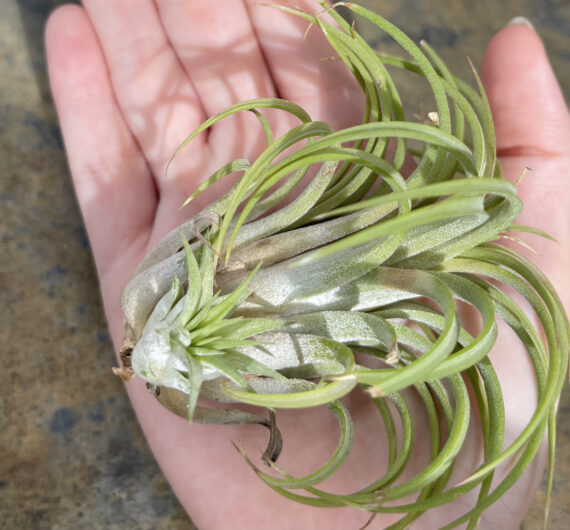
Tillandsias, or air plants, are beloved for their unique growing habits, easy maintenance, and their ability to propagate naturally. One of the most rewarding parts of caring for these fascinating plants is watching them produce pups—tiny, new air plants that grow from the base of the mother plant after it blooms. If you’re looking to expand your collection or share air plants with friends, propagating Tillandsias from pups is an easy and exciting way to do it. Let’s walk through the entire process of growing your Tillandsia collection from pups, from identifying new growth to separating and caring for your new plants.
What Are Tillandsia Pups?
Tillandsia pups are small offsets, or baby plants, that grow from the base of a mature, mother plant after it blooms. These pups are essentially clones of the parent plant and will eventually grow into full-sized air plants, capable of blooming and producing pups of their own. The formation of pups is a natural part of the air plant’s life cycle, which ensures that even as the mother plant ages, new plants continue to thrive.
When Do Tillandsias Produce Pups?
Most Tillandsias will bloom only once in their lifetime. After the blooming period, the plant shifts its energy from producing flowers to creating pups. The number of pups a plant produces can vary depending on the species and overall health of the mother plant, but typically, it will generate anywhere from 1 to 8 pups over the course of several months.
Signs of Pup Development:
- Look for tiny shoots emerging from the base of the plant.
- These pups may initially be small but will continue to grow alongside the mother plant until they’re ready to be separated.
How to Propagate Tillandsia Pups: Step-by-Step Guide

Step 1: Wait for the Pups to Grow
The first step to propagating Tillandsias is patience. While it’s exciting to see the pups start to grow, it’s important to wait until they’re mature enough before separating them from the mother plant.
When are the pups ready?
Pups should ideally be one-third to one-half the size of the mother plant before they are separated. This ensures that the pups are strong enough to survive on their own without relying on the nutrients provided by the parent plant.
Step 2: Separating the Pups from the Mother Plant
Once the pups have reached the appropriate size, it’s time to separate them. The process is straightforward, but be gentle to avoid damaging the pups or the mother plant.
How to Separate Tillandsia Pups:
Examine the Base: Look at the base of the mother plant where the pups are attached. You’ll notice that each pup has its own base, which is connected to the mother by a thin stem.
Gently Pull or Twist: Using clean hands or a pair of sterilized scissors, gently pull or twist the pup away from the mother plant. If the pup doesn’t come off easily, use scissors to carefully cut it off at the base where it meets the mother plant.
Check for Rot: While separating the pups, inspect both the mother plant and pups for any signs of rot or decay. If you notice any unhealthy parts, trim them off with sterilized scissors to prevent the spread of disease.
Step 3: Caring for Your New Tillandsia Pups
Now that you’ve separated the pups from the mother plant, it’s time to give them the care they need to thrive on their own.
Watering:
Soak or Mist the Pups: Just like mature air plants, pups need regular watering. Mist them lightly every 2-3 days or soak them in water for 20-30 minutes once a week.
Dry Properly: Ensure that the pups dry completely after watering, as standing water can cause rot, especially in young plants.
Light:
Bright, Indirect Light: Place your new pups in bright, indirect light. Pups need plenty of light to grow, but avoid direct sunlight, which can scorch the leaves and hinder their development.
Avoid Overexposure: If you’re growing your Tillandsia pups outdoors, ensure they’re in a shaded or partially shaded spot to protect them from too much sun exposure.
Air Circulation:
- Good Airflow: Like mature Tillandsias, pups need good air circulation to thrive. Keep them in a well-ventilated area where they can dry properly after watering and receive fresh air to support healthy growth.
Step 4: Care for the Mother Plant
After separating the pups, the mother plant may continue to live for several months or even years, but its energy will be primarily focused on supporting the new plants. Continue to care for the mother plant as usual—watering, providing light, and ensuring good air circulation.
- If More Pups Develop: Some Tillandsia species may produce more pups after the first separation. If this happens, you can repeat the propagation process when the new pups reach the appropriate size.
Propagating Tillandsias from pups is a rewarding experience that allows you to grow your air plant collection with ease. By waiting for the pups to mature, carefully separating them, and providing the right care, you can nurture a new generation of air plants in your home. As your Tillandsia collection grows, you’ll enjoy watching these fascinating plants thrive and bloom, knowing that they’ll continue the cycle by producing pups of their own.